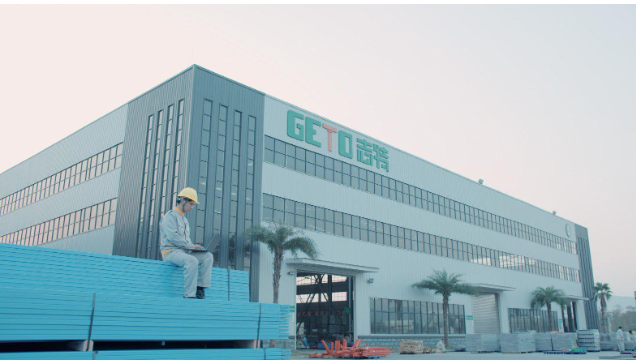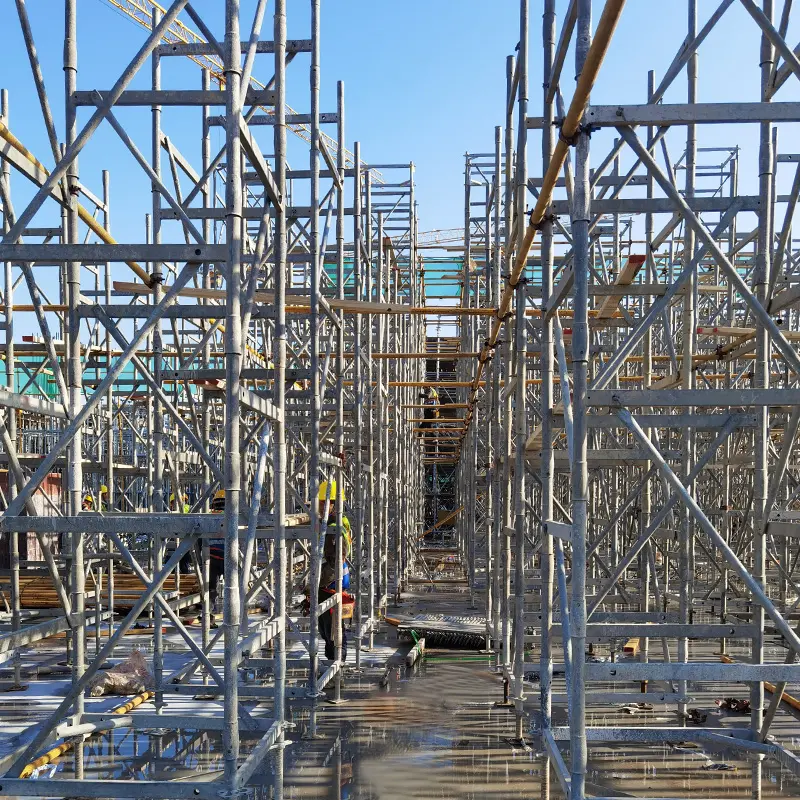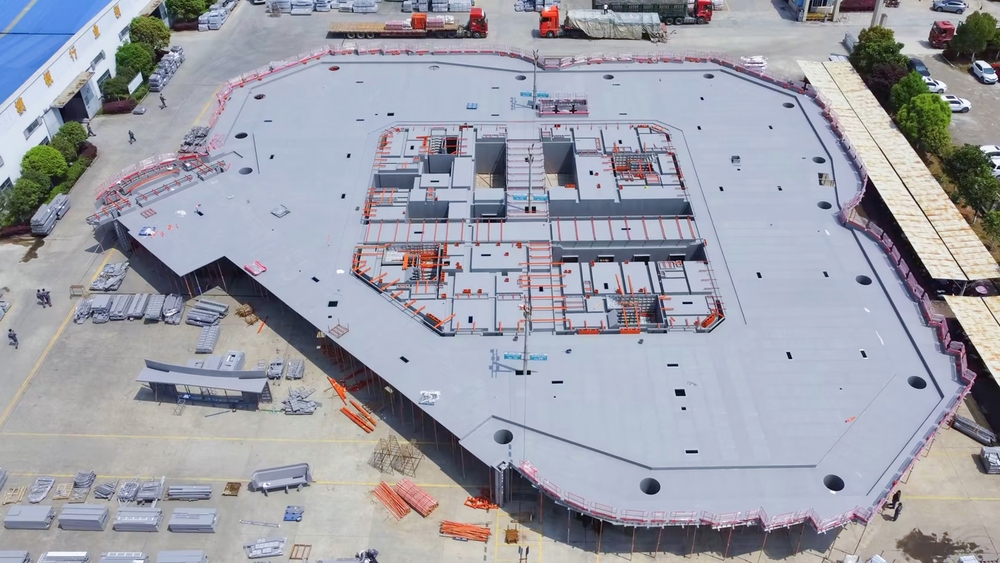In the dynamic landscape of modern construction, the demand for safe, efficient, and sustainable solutions for high-rise construction has never been greater. GETO, a Chinese listed company (Stock Code: 52290966), has positioned itself as a global leader in green construction and new energy, delivering innovative systems that meet these critical needs. Central to its portfolio is the GTP100 Automatic Hydraulic Climbing Formwork System, a state-of-the-art solution designed to streamline the construction of large-scale structures such as internal shafts, facade walls, shear walls, massive columns, bridge towers, signal towers, and silos. This article provides an in-depth exploration of the GTP100 system, detailing its applications, components, technical specifications, operational principles, and real-world impact.
The Need for Advanced Climbing Formwork Systems
Traditional formwork systems, while functional for low-rise construction, often struggle to meet the demands of modern high-rise projects. These conventional methods require extensive manual labor, frequent assembly and disassembly, and pose significant safety risks at height. The GTP100 Automatic Hydraulic Climbing Formwork System addresses these challenges by automating the climbing process, integrating robust components, and prioritizing worker safety. By leveraging hydraulic technology and a modular design, the GTP100 offers a transformative approach to constructing tall structures, reducing labor costs, minimizing material waste, and enhancing construction efficiency.
Overview of the GTP100 System

The GTP100 Automatic Hydraulic Climbing Formwork System is a sophisticated construction technique that integrates a climbing bracket, formwork platform system, and suspension bracket, all securely attached to the concrete structure. The system operates through a cyclical process: once the formwork is stripped from the cured concrete, it is driven upward by hydraulic cylinders and guided by a climbing rail to the next level. This process repeats seamlessly, enabling continuous vertical progression throughout the construction process. The formwork is integrated with the climbing brackets, moving as a single unit with the traveling units, which significantly reduces labor costs. The enclosed construction environment effectively prevents falls from heights, ensuring a safer workplace.
Key Applications
The GTP100 system is suitable for a variety of large structures, including:
- Internal shafts and core walls for high-rise buildings, providing structural support and facilitating vertical construction.
- Facade walls and shear walls, essential for maintaining structural stability in tall buildings.
- Massive columns, bridge towers, signal towers, and silos, critical components of infrastructure projects.
The system’s operational conditions are strictly defined to ensure safety and reliability:
- Operations must occur in the absence of severe weather conditions, such as thunderstorms, rain, snow, fog, frost, haze, or hail.
- The basic wind pressure must not exceed Level 5 (approximately 24.5–28.5 m/s).
- For wind speeds exceeding Level 7 (approximately 13.9–17.1 m/s), typhoon reinforcement measures are required for the climbing formwork bracket.
These conditions adhere to the Technical Standard for Hydraulic Climbing Formwork Engineering of the People’s Republic of China.
Features and Advantages
The GTP100 system offers a range of features and advantages that make it a preferred choice for modern construction projects.
1. Safety
The GTP100 system prioritizes worker safety by providing all-round operational platforms that create a secure working environment. This enclosed design effectively prevents falls from heights, a significant risk in high-rise construction. By ensuring workers operate within a protected space, the system enhances safety standards and reduces the likelihood of accidents.
2. Cost-Efficiency
The system is highly cost-efficient, as it saves materials and labor. The climbing bracket is assembled at a low level and continuously climbs to the top, reducing formwork damage. This approach minimizes the need for frequent replacements, lowering material costs. Additionally, the integration of formwork and climbing brackets reduces the labor required for assembly and disassembly, further enhancing economic viability.
3. Convenience
The GTP100 system streamlines the construction process through its integrated design. The formwork moves forward and back with the traveling units, eliminating the need for repetitive manual adjustments. The flipping platform facilitates formwork replacement and rebar binding, making construction tasks more efficient and convenient.
Key Components
The GTP100 system comprises several critical components, each meticulously designed for durability and functionality. The detailed descriptions of these components, which are accurately reflected below:
Climbing System
The climbing system is the core mechanism enabling the automated ascent of the GTP100. Its components include:
- Climbing Rail: Guides the system during vertical movement.
- Hydraulic Cylinder: Powers the climbing mechanism with a 250 mm stroke.
- Lifting Mechanism and Climbing Head: Ensure precise and stable movement.
- Vertical Profile, Main Horizontal Profile, Diagonal Bracing Spindle Strut, and Supporting Carriage: Provide structural support and enhance stability.
Main Platform Beam

The main platform beam is a primary load-bearing component:
- H200 Beam: Supports the entire load of the upper platform and lower platform.
- 20# U Channel Beam: Bears the formwork weight.
- Modular Design: Features 120 mm hole spacing on the upper surface with end flange connections for equal strength.
Lower Platform Hanging Bracket
This component supports the lower levels of the system:
- -1F Vertical Suspension Profile and Horizontal Profile: Provide structural support.
- Diagonal Bracing: Reinforces stability.
- -2F Vertical Suspension Profile and Horizontal Profile: Extend support to lower levels.
Formwork Traveling Unit
The formwork traveling unit enables seamless movement of the formwork:
- Vertical Water, Horizontal Profile, and Diagonal Bracing Spindle Strut: Ensure alignment and stability during movement.
Anchoring System
The anchoring system secures the GTP100 to the concrete structure:
- Attachment Support, Embedded Climbing Cone, M36 Screw, Stop Anchor, and Sealing Sleeve: Provide secure fastening and maintain structural integrity.
Upper Platform Bracket
The upper platform bracket supports the upper levels:
- 10# U Channel for Vertical Profile (double piece) and Horizontal Profile (single piece): Forms a framework with a platform width of 1.4 meters on +1F and +2F levels.
- Diagonal Bracing: Enhances stability.
- Flipping Platform Horizontal Profile: Facilitates formwork replacement and rebar binding.
Technical Specifications
The GTP100 system is engineered for precision and performance, with technical specifications clearly show as follows:
- Climbing Distance per Stroke: 150 mm
- Hydraulic Cylinder Stroke: 250 mm
- Maximum Climbing Height: 5.5 m (Add support in the middle of the climbing rail, otherwise it is 4.5m)
- Maximum Lifting Capacity: 100 kN
Climbing Process Principles
The Climbing Process Principle is divided into the Climbing Rail Principle and Climbing Bracket Principle.
Climbing Rail Principle

The climbing rail serves as the guiding mechanism for the system’s vertical ascent. It ensures that the climbing brackets and formwork move in a controlled and stable manner, driven by the hydraulic cylinders. The climbing rail maintains alignment and supports the system’s weight during each climb.
Climbing Bracket Principle

The climbing bracket integrates the formwork, platform system, and suspension bracket into a cohesive unit. After the concrete cures and the formwork is stripped, the climbing bracket is lifted by the hydraulic cylinders along the climbing rail to the next level, enabling continuous construction without manual repositioning.
Project Case: Residential Building in Asia
The Residential Building in Asia as a project case where the GTP100 system was successfully implemented,and the system’s application demonstrates its capability to support high-rise construction. The GTP100 likely facilitated rapid vertical progression, enhanced worker safety, and reduced labor costs.
Why choose GETO?
GETO is a global leader in green construction and new energy, with a focus on formwork, prefabricated construction, and “Photovoltaics, Storage, and Charging” projects. The company was listed on the ChiNext board of the A-share market in 2021 and has established 12 production bases worldwide, including:
- Greater Bay Area: No. 13 Heing Road, Taulhang New District, Zhonghan City, Guangdong Province
- Southern China Production Base I: Guachen Lake Science and Technology Park, Jiangmen City, Guangdong Province
- Southern China Production Base II: Southern China Industrial Technology Park, Huizhou City, Guangdong Province
- Eastern China Production Base I: Guangdong Industrial Park, Fuzhou City, Jiangxi Province
- Central China Production Base: Hi-tech Industry Development Zone, Xianning City, Hubei Province
- Southwest China Production Base: Modern Manufacturing Industrial Park, Tongnan High-Tech District, Chongqing City
- Northwest China Production Base: The Circular Economy Park, Anding District, Dingxi City, Gansu Province
- Hainan Production Base: Gold Medal Port Industrial Park, Lingpo County, Hainan Province
- ASEAN Production Base: Hangzhou, Zhejiang, Malaysia
- Singapore Production Base: West Region, Singapore
- Saudi Arabia Production Base: Riyadh, Saudi Arabia
GETO has registered 31 international trademarks, and its products and services are sold worldwide (Page 2). This global presence ensures that the GTP100 system is accessible to construction projects across diverse regions.
Conclusion
The GETO GTP100 Automatic Hydraulic Climbing Formwork System represents a pinnacle of innovation in high-rise construction. By integrating hydraulic technology, a modular design, and a focus on safety, efficiency, and cost-effectiveness, the system addresses the challenges of constructing large-scale structures.
As part of GETO’s broader mission to advance green construction, the GTP100 system contributes to safer, more efficient, and sustainable construction practices worldwide. With 12 production bases and 31 international trademarks, GETO continues to lead the industry, delivering solutions that shape the future of high-rise construction.







